- Scientific name: Polygonum tenue
- Species of Greatest Conservation Need (MA State Wildlife Action Plan)
Description
Slender knotweed (Polygonum tenue) is a slender annual member of the buckwheat family (Polygonaceae). Slender knotweed produces stems, reaching heights of 5-50 cm (1.9-19.6 in) which are square in cross-section. It produces narrow leaves with pointed tips, and two folds along their length. The leaves are alternately arranged on the stem, and measure 1.2-2.5 cm (½-1 ½ in) long and up to 8 mm (⅓ in) wide. Its flowers are arranged in the axils of small leaves in small groups of 1-3. Each flower measures 2.5-4.2 mm (0.1-0.17 in) long and is composed of green tepals surrounding white petals. These flowers each produce a single, black, three-sided, elliptic to oblong seed which measures 2.3-4 mm (0.09-0.16 in).
Slender knotweed is superficially similar to coastal jointed knotweed (Polygonum articulatum) and upright knotweed (Polygonum erectum) and can be distinguished by its stem which is sharply square in cross-section.
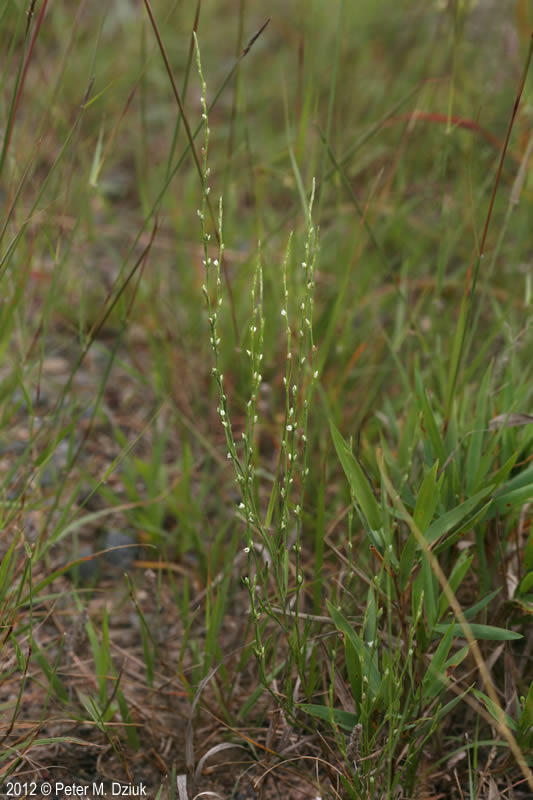
Slender knotweed plant.
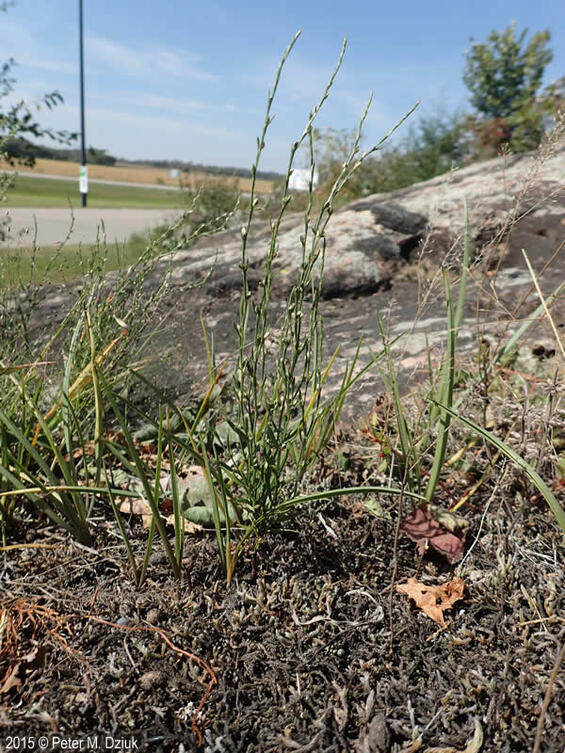
Slender knotweed plant. Photos by Peter Dziuk.

Slender knotweed flowers close-up.
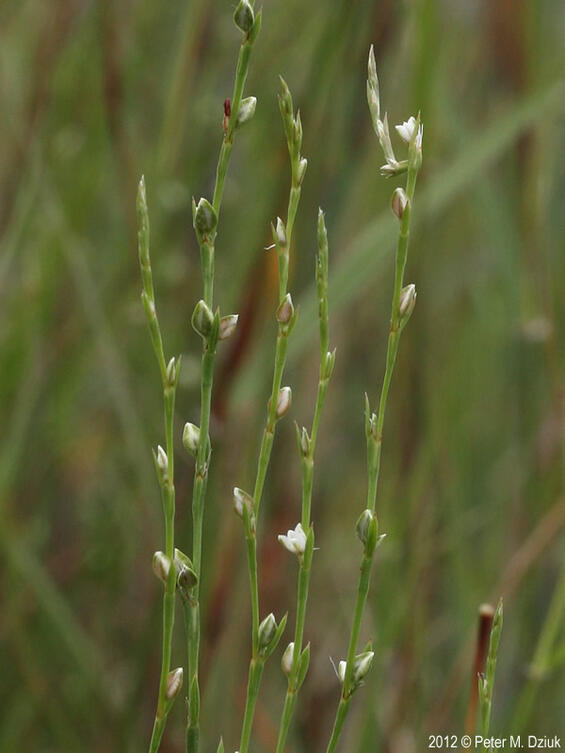
Slender knotweed flowers.
Life cycle and behavior
Slender knotweed flowers between August and September, and fruits mature during the same period. Slender knotweed may benefit from occasional fire.
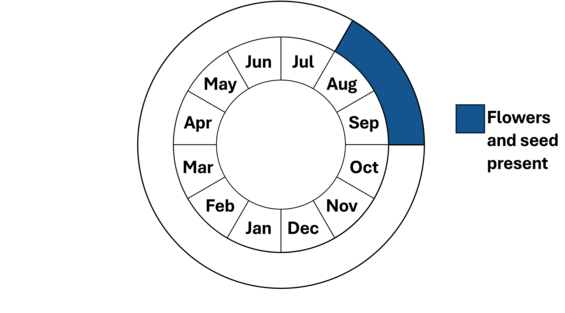
Population status
Slender knotweed has recently been elevated to a species of greatest conservation need and is maintained on the plant Watch List. These are species that the state botanists are concerned might be decreasing or do not have sufficient information to rank. Slender knotweed currently has only nine known populations in Middlesex, Worcester, Hampden, Hampshire, Franklin, Norfolk and Worcester counties that have been observed since 1999 and reported to the MassWildlife’s Natural Heritage and Endangered Species Program (NHESP). Thirty additional populations have not been observed recently. It has only recently been included as a species of greatest conservation need. If you see any rare species, please report them through NHESP Heritage Hub.
Distribution and abundance
Slender knotweed is present throughout eastern North America, from Maine south to Georgia and west to Kansas. It is of conservation concern in several states, including vulnerable in Illinois, New Jersey, Kansas, Kentucky, and New York; imperiled in Massachusetts and North Carolina; critically imperiled in New Hampshire and Vermont; and possibly extirpated from Maine (NatureServe 2025). Known populations in Massachusetts are generally small.
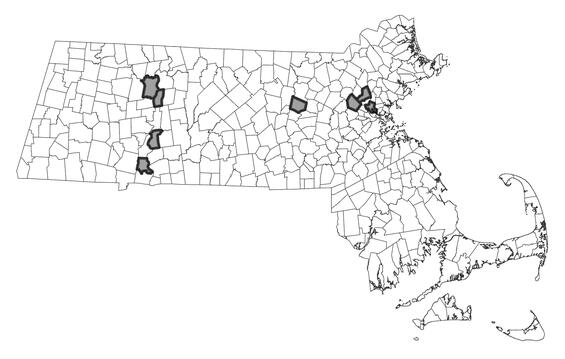
Distribution in Massachusetts. 1999-2024. Based on records in the Natural Heritage Database
Habitat
In Massachusetts, slender knotweed inhabits sites with dry soils which are either low in organic matter or which are thin and overlay bedrock outcrops. These communities include balds, ledges, and talus slopes, and generally lack tree cover, or have sparse woody vegetation in those locations where slender knotweed grows. Plant species known to co-occur with slender knotweed in Massachusetts include Carolina rose (Rosa carolina), poverty grass (Danthonia spicata), fern-leaved false foxglove (Aureolaria pedicularia), late purple American-aster (Symphyotrichum patens), ledge spikemoss (Selaginella rupestris), bluecurls (Trichostema dichotomotum), oldfield-toadflax (Nuttallanthus canadensis), little bluestem (Schizachyrium scoparium), orange-grass St. John’s-wort (Hypericum gentianoides), and various goldenrods (Solidago spp.). In locations where slender knotweed occurs within canopy gaps, tree cover is known to include eastern red cedar (Juniperus virginiana), oaks (Quercus spp.), hickories (Carya spp.), and hop hornbeam (Ostrya virginiana). Several populations are known from sites with basalt bedrock and evidence of fire.
Healthy habitats are vital for supporting native wildlife and plants. Explore habitats and learn about conservation and restoration in Massachusetts.
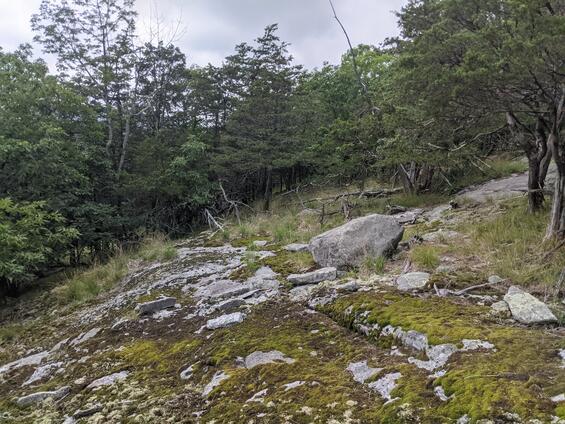
Slender knotweed habitat. Photo by Matt Charpentier.
Threats
As an annual species, slender knotweed is vulnerable to changes in vegetative conditions resulting from succession and alterations to soil moisture due to drought or high precipitation. Changes to weather patterns due to climate change may therefore threaten the viability of slender knotweed populations in Massachusetts. Populations of slender knotweed adjacent to trails may be impacted by trampling.
Conservation
Survey and monitoring
Of the 40 locations where slender knotweed has been documented in Massachusetts, only 9 (22%) are considered extant (observed since 1999). Sites documented to historically host slender knotweed should be revisited to determine whether populations may persist. Additional unrecorded populations of slender knotweed may be present within suitable habitats in the state and may be easily overlooked due to the species size and inconspicuous growth form. Please notify NHESP of observations of slender knotweed using the Heritage Hub web application.
Management
Management for slender knotweed might include rerouting trails away from populations to prevent trampling. Habitats might need to be opened through vegetation trimming, or invasive species might need to be removed to prevent shading. All active management of rare plant populations (including invasive species removal) is subject to review under the Massachusetts Endangered Species Act and should be planned in close consultation with NHESP.
Research needs
It is not known how seed is moved from a population to a new location. Research is needed to determine whether this plant can be grown in a nursery or garden setting for purposes of reintroductions. Questions about seed germination and seed storage over winter will need to be answered.
Acknowledgements
MassWildlife acknowledges the expertise of Matt Charpentier, who contributed substantially to the development of this fact sheet.
References
NatureServe. 2025. NatureServe Network Biodiversity Location Data accessed through NatureServe Explorer [web application]. NatureServe, Arlington, Virginia. Available https://explorer.natureserve.org/. Accessed: 3/21/2025.
New England Wild Flower Society’s Flora Novae Angliae: A Manual for the Identification of
Native and Naturalized Higher Vascular Plants of New England. 2011. New Haven: Yale University Press.
Minnesota Wild Flowers. Polygonum tenue. https://www.minnesotawildflowers.info/flower/slender-knotweed Accessed 3/21/2025
Contact
| Date published: | May 6, 2025 |
|---|